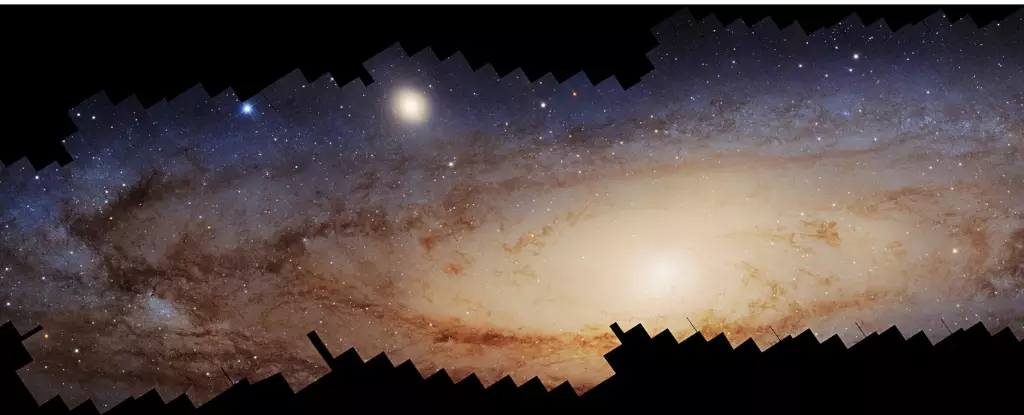The Andromeda Galaxy, known scientifically as M31, is our closest spiral galaxy and serves as a vital bridge in our quest to understand the greater cosmos. Located approximately 2.537 million light-years from Earth, it stands as the most distant object visible to the unaided eye, taking the form of a faint, smudgy patch in the night sky. Its proximity not only allows for observational studies with powerful telescopes but provides an unparalleled opportunity to study the fundamental dynamics of galaxies similar to our Milky Way.
Although M31 is often overshadowed by the grandiosity of cosmic phenomena, its exploration is indispensable. Astronomers have long relied on advanced observational tools, including the legendary Hubble Space Telescope, which has synthesized breathtaking mosaics of Andromeda. These detailed images hold critical data that could reshape our understanding of the Milky Way and offer insights into galactic formation and evolution.
One of the highlights of Andromeda studies is the colossal mosaic produced by the Hubble Space Telescope, which culminated in a remarkable 2.5-gigapixel image. This extensive project spanned a decade, demanding over a thousand orbits around the Earth to collect data on M31’s vast stellar populations. The resulting images reveal approximately 200 million luminous stars, although dimmer stars, such as red dwarfs, elude detection.
This endeavor, comprising the Panchromatic Hubble Andromeda Southern Treasury (PHAST) and the Panchromatic Hubble Andromeda Treasury (PHAT) programs, underscores the collaboration among astronomers to discern the many aspects of Andromeda. The sheer scale of this imaging project is indicative of the intricacies involved in mapping not just M31 but also the comparative features of other galaxies. The insights gained from this feat not only serve to enhance our knowledge of Andromeda but also provide a comparative framework to scrutinize the Milky Way.
One compelling reason for investigating the Andromeda Galaxy is its status as a proxy for our own galactic home. Both the Milky Way and M31 fall under the category of barred spiral galaxies, sharing several characteristics that make direct comparisons practical. Observations of M31 allow scientists to sidestep the complications often encountered when studying more distant galaxies, such as issues related to distance inaccuracies and line-of-sight interferences.
As stated in the research published in the Astrophysical Journal, Andromeda presents a relatively clean canvas against which cosmological phenomena can be studied in greater context. By examining its stellar population, star formation rate, and even the metallicity of gases and stars, researchers gain clues about the environment in which both galaxies exist.
Perhaps the most exciting aspect of studying Andromeda lies in revealing its complex geological history rooted in past galactic mergers. The research highlighted the striking differences between the southern and northern disks of M31, with the former displaying symptoms of extensive disturbances—suggestive of a tumultuous history influenced by galactic interactions.
An intriguing element of this analysis is the early-type dwarf galaxy M32, which hints at M31’s violent past. Many scientists theorize that M32 could be the remnant core of a once-massive galaxy swept into Andromeda’s gravitational embrace—an event that occurred roughly two billion to three billion years ago. The consequent effects are observed in the current morphology of the galaxy, which bears the scars of this merger through structures like the Giant Southern Stream, a tidal debris feature indicative of ancient galactic collisions.
Looking ahead, the astronomical community is on the verge of a new era of exploration thanks to upcoming instruments such as NASA’s Nancy Grace Roman Space Telescope. This infrared telescope promises to revolutionize our understanding of Andromeda and its surrounding features. With the ability to capture the equivalent of 100 high-resolution Hubble images in a single exposure, the Roman Telescope will offer unprecedented clarity and depth in our studies of M31, giving us critical insights into its formation and evolution over cosmic time.
The Andromeda Galaxy holds an eternal fascination for astronomers due to its unique characteristics and proximity to our own Milky Way. As we delve deeper into the observations produced by intricate projects such as PHAT and PHAST, we increasingly piece together the intricate tapestry of galactic formation and history. The forthcoming capabilities of the Roman Space Telescope herald an exciting future, enhancing our existing knowledge and leading to newfound discoveries. Andromeda serves not only as a neighbor but also as an essential chapter in the ongoing saga of our universe’s evolution.

